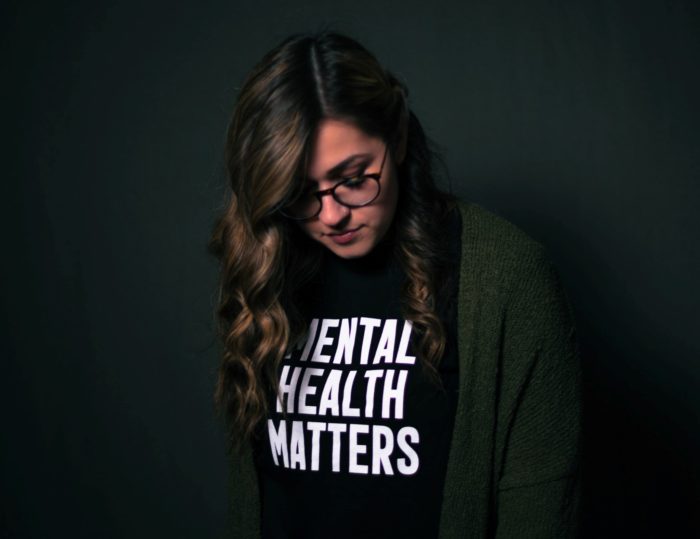The Healthy Minds report reveals the state of mental health on college campuses, including that more than 80% have suffered academically since the pandemic began.
 Matthew Ball/Unsplash
Matthew Ball/Unsplash “Make it til May.”
Dr. Sarah Lipson, assistant professor at Boston University’s School of Public Health, noted the potential double meaning in those signs that have popped up on bustling Commonwealth Avenue near campus.
Meant to highlight the struggle to maintain its residential setup through the end of the spring semester, the placards easily could be interpreted another way, she says: “How do we look out for another as much as possible? How do we bring compassion and kindness? We might be crawling to the finish line in May.”
Lipson’s reference is noteworthy. As Associate Director of the Healthy Minds Network based out of BU and the University of Michigan, she is also heavily involved in the annual Healthy Minds Study that assesses the state of mental health at college campuses across America.
2020 was an unforgiving year, punctuated by the COVID-19 pandemic. Of the 33,000 students at 36 institutions that took part in the most recent web-based survey during the fall of 2020, 60% said they needed help during the past 12 months for emotional or mental health distress. Another 83% said those issues affected academic performances at least one day during the previous month, and more than a quarter said they experienced it for six or more days.
The results were “quite jarring”, even for Lipson, who has studied mental health in adolescent populations extensively.
“Every semester for the past about three years has been the highest prevalence that we’ve ever seen,” she says of the annual survey. “We’ve seen that trend over the past 10 years and the past three years even more so. In the fall of 2020, we had close to half of students who screened positively for clinically significant symptoms of major depression or anxiety. As someone who works closely in the data and monitors this trend semester by semester, it did not shock me, but it is kind of the motivation and the urgency behind everything that I do.”
The significance of the study
Lipson, who worked closely on the study with Daniel Eisenberg, a former University of Michigan professor now at the UCLA Fielding School of Public Health, notes that “75% of lifetime mental illnesses will onset by age 24 … and about half of each birth cohort is enrolling in U.S. postsecondary education.”
That puts an enormous burden on colleges and universities to be proactive in its outreach to the students they serve and to truly understand the numbers. Its why so many of them, year after year, have turned to be included in the Healthy Minds Study. They can assess how well they are doing as a campus in providing services and promoting messaging that get students the help they need.
To researchers such as Lipton who have seen the trends and patterns, there are few surprises. But there are notable numbers for those who don’t delve into the data frequently and red flags that highlight the importance of care and interventions.
From the fall of 2020 study:
- 13% of students have entertained thoughts of suicide
- 23% have had non-suicidal self-injury episodes
- 39% say they have experienced some type of depression
- 34% say they have had some level of anxiety
Many during the pandemic admitted to struggling with isolation or feeling left out. The majority (60%) say they are binge-drinking at least once a week (at least 4 drinks for women and 5 for men). Another 35% are getting less than one hour of exercise per week.
Academic distractions are a major cause for concern. The pressure to succeed in this environment, whether it be remote learning or dealing with the fallout from the pandemic, can be overwhelming, especially for students who are experiencing distress.
“I really worry about a student who might be taking their first advanced class that they have taken all the prerequisites for and they’re not being as successful as they wish they were,” Lipson says. “And they perceive that to be, ‘I don’t actually have an aptitude or a talent in this field.’ I don’t think anybody’s best talent is on display. We need to remind students that they do belong, that they are smart, that they are capable and talented or we’re going to risk losing talent.”
Depression leads to serious outcomes, she says, including a two-fold increase in the number of students who either drop out or stop out. And the populations most affected are often those from underserved communities.
“For a long time, my research team and I have been trying to bring together these two national dialogues around persistence and retention in higher education and the inequalities there with the rising mental health problems,” Lipson says. “The data that we’re collecting during the pandemic is putting an exclamation point on that topic. We’re at risk of seeing inequalities widen in terms of who is graduating from college due to financial stress, family obligations and mortality from COVID. The students who are in school, particularly students of color and low-income students, there’s an enormous urgency right now to support them academically and to support their wellbeing.”
Many of those students, Lipson says, might be reluctant to reach out for help so it is imperative that an array of supports are provided to ensure their success and the overall success of the institution.
“We’ve seen that the proportion of students who are struggling relative to the proportion of students who are accessing care, there’s a wide treatment gap,” she says. “That’s where we see large inequalities, that students of color, low-income, first-gen students are much less likely to be accessing care when they’re experiencing mental health problems. If we’re going to maintain any amount of equity in terms of who’s graduating from college, we’re going to need to be able to address the unique mental health problems that students of color are facing.”
Getting students help
The survey highlights both how students are feeling about their emotional and mental health and where they are most likely to turn to support, if at all. The majority of those polled (60%) say they’ve never been diagnosed with a mental health disorder, and more than 75% say they have not been prescribed psychotropic medication. However, those numbers don’t match those who admitted some level of anxiety or depression.
So who are they turning to for help? In the report, 40% said they turn to a friend, while about a third say they called on a family member or significant other for support. 35% said they hadn’t reached out to anyone.
Those that cited potential barriers for not being able to get help included these: 40% said there was no need for services, 21% said they preferred to deal with issues on their own; 18% cited a lack of time and 17% said treatment was cost-prohibitive.
About a third of those polled said they are uncertain or do not know about mental health services available on campus.
Lipson says that mental health initiatives launched by colleges and universities around student wellbeing must be a “shared responsibility” and she says, driven by campus leaders.
“That extends well beyond the Counseling Center or the Help Center to every aspect of student life and an academic life,” she says. “So, what is the optimal role that a faculty member can play? What can we do to create the conditions that might allow a student to thrive or that give a student the best chance to thrive?”
She mentions a simple policy of allowing students to hand in assignments at 5 p.m. instead of 9 a.m. That takes the burden and pressure off students from pulling all-nighters and skipping meals, conditions that might affect their wellbeing.
“If all faculty can be told that, and encouraged to do that, by campus leaders, it sends a really important message to students at the beginning of the semester,” she says. “You can say when reviewing the syllabus, ‘you’ll note in this some guidelines for this class that I have put in place because I care about you as a person, and I’m open to suggestions.’ Young people have a lot of really important ideas for how to improve the student experience.”
Whatever strategies an institution employs, it should be targeted at all students, Lipson says, “thinking about mental health along the continuum, from students who are thriving to students who are really in crisis.”
And during the pandemic it is important too to consider expectations, consider student needs and be supportive.
“As a faculty member, I find that it resonates with students to just acknowledge the challenge,” Lipson says. “We’re all on the same team. We’re all going through this. This is really, really hard … and so normalizing that. Hearing regularly from staff and faculty that their university understands that is important.”
